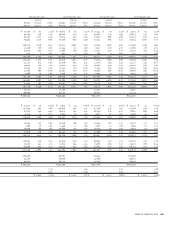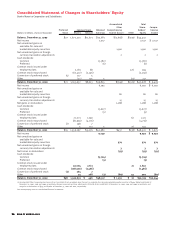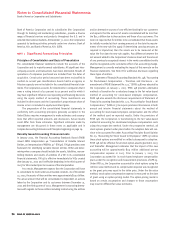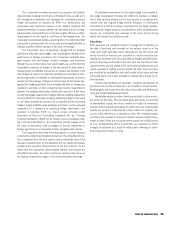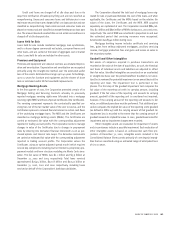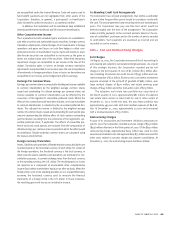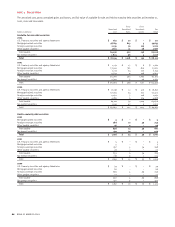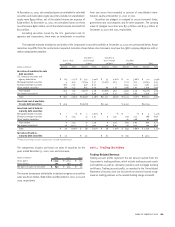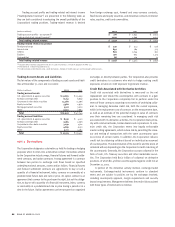Bank of America 2002 Annual Report Download - page 80
Download and view the complete annual report
Please find page 80 of the 2002 Bank of America annual report below. You can navigate through the pages in the report by either clicking on the pages listed below, or by using the keyword search tool below to find specific information within the annual report.
78 BANK OF AMERICA 200278 BANK OF AMERICA 200278 BANK OF AMERICA 2002
Statement of Financial Accounting Standards No. 133, “Accounting
for Derivative Instruments and Hedging Activities,” (SFAS 133) as
amended by Statement of Financial Accounting Standards No. 137,
“Accounting for Derivative Instruments and Hedging Activities — Deferral
of Effective Date of Financial Accounting Standards Board Statement
No. 133,” and Statement of Financial Accounting Standards No. 138,
“Accounting for Certain Derivative Instruments and Certain Hedging
Activities — an amendment of FASB Statement No. 133,” was adopted by
the Corporation on January 1, 2001. The impact of adopting SFAS 133 to
net income was a loss of $52 million (net of related income tax benefits
of $31 million) and a net transition gain of $9 million (net of related
income taxes of $5 million) included in other comprehensive income on
January 1, 2001.
On January 8, 2003, the Federal Financial Institutions Examination
Council (FFIEC) issued guidance on “Account Management and Loss
Allowance Guidance for Credit Card Lending.” This guidance addresses
account management, allowance for loan losses and fee recogni-
tion practices for institutions that offer credit card programs. The
Corporation is in compliance with the material portions set forth in this
guidance. Therefore, it will not have an impact on the Corporation’s
results of operations or financial condition.
Cash and Cash Equivalents
Cash on hand, cash items in the process of collection and amounts due
from correspondent banks and the Federal Reserve Bank are included
in cash and cash equivalents.
Securities Purchased under Agreements to Resell and
Securities Sold under Agreements to Repurchase
Securities purchased under agreements to resell and securities sold
under agreements to repurchase are treated as collateralized financ-
ing transactions and are recorded at the amounts at which the secu-
rities were acquired or sold plus accrued interest. The Corporation’s
policy is to obtain the use of securities purchased under agreements
to resell. The market value of the underlying securities, which collater-
alize the related receivable on agreements to resell, is monitored,
including accrued interest. Additional collateral is requested when
deemed appropriate.
Collateral
The Corporation has accepted collateral that it is permitted by con-
tract or custom to sell or repledge. At December 31, 2002, the fair
value of this collateral was approximately $47.9 billion of which
$29.9 billion was sold or repledged. At December 31, 2001, the fair
value of this collateral was approximately $30.4 billion of which
$21.5 billion was sold or repledged. The primary source of this col-
lateral is reverse repurchase agreements. The Corporation pledges
securities as collateral in transactions that are primarily repurchase
agreements, public and trust deposits, treasury tax and loan and
other short-term borrowings. This collateral can be sold or repledged
by the counterparties to the transactions.
In addition, the Corporation obtains collateral in connection with
its derivative activities. Required collateral levels vary depending on
the credit risk rating and the type of counterparty. Generally,
the
Corporation accepts collateral in the form of cash, U.S. Treasury secu-
rities and other marketable securities.
Trading Instruments
Financial instruments utilized in trading activities are stated at fair
value. Fair value is generally based on quoted market prices. If quoted
market prices are not available, fair values are estimated based on
dealer quotes, pricing models or quoted prices for instruments with
similar characteristics. Realized and unrealized gains and losses are
recognized in trading account profits.
Derivatives and Hedging Activities
All derivatives are recognized on the balance sheet at fair value,
taking into consideration the effects of legally enforceable master
netting agreements which allow the Corporation to settle positive
and negative positions with the same counterparty on a net basis.
For exchange traded contracts, fair value is based on quoted market
prices. For non-exchange traded contracts, fair value is based on
dealer quotes, pricing models or quoted prices for instruments with
similar characteristics. The Corporation designates a derivative as
held for trading or hedging purposes when it enters into a derivative
contract. Derivatives designated as held for trading activities are
included in the Corporation’s trading portfolio with changes in fair
value reflected in trading account profits. Some credit derivatives
used by the Corporation do not qualify for hedge accounting under
SFAS 133 and despite being effective economic hedges, changes in
these derivatives are included in trading account profits.



